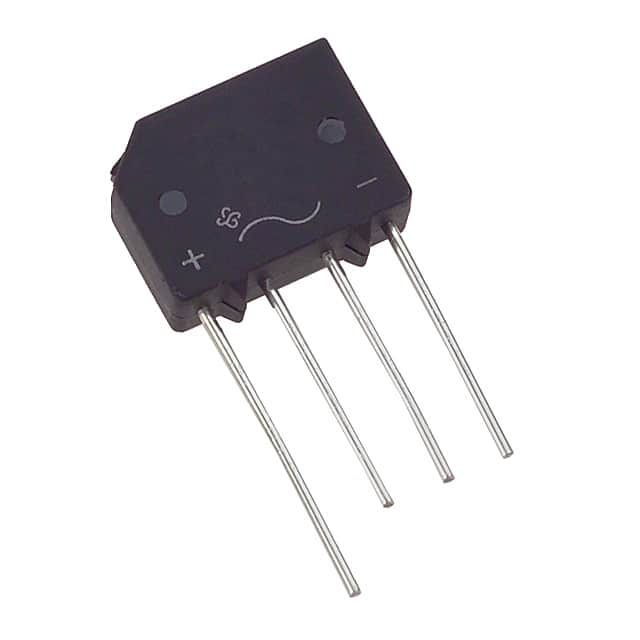2KBP10ML-6767E4/72
Product Overview
Category
The 2KBP10ML-6767E4/72 belongs to the category of semiconductor devices.
Use
It is commonly used in electronic circuits for rectification and voltage regulation.
Characteristics
- High current capability
- Low forward voltage drop
- Fast switching speed
Package
The 2KBP10ML-6767E4/72 is typically available in a standard through-hole package.
Essence
This product is essential for converting alternating current (AC) to direct current (DC) in various electronic applications.
Packaging/Quantity
It is usually packaged in reels or tubes, with quantities varying based on manufacturer specifications.
Specifications
- Maximum Average Forward Current: 2A
- Peak Forward Surge Current: 50A
- Reverse Voltage: 1000V
- Forward Voltage Drop: 1.1V at 2A
Detailed Pin Configuration
The 2KBP10ML-6767E4/72 typically has four pins, with specific pin configurations based on the package type. Refer to the datasheet for detailed pinout information.
Functional Features
- Efficient rectification of AC to DC
- Reliable voltage regulation
- Suitable for high-frequency applications
Advantages
- High current handling capability
- Low power dissipation
- Fast response time
Disadvantages
- Higher cost compared to standard diodes
- Larger physical size
Working Principles
The 2KBP10ML-6767E4/72 operates on the principle of semiconductor junction rectification, allowing the flow of current in one direction while blocking it in the reverse direction.
Detailed Application Field Plans
This product is widely used in power supplies, motor drives, inverters, and other electronic systems requiring efficient AC to DC conversion and voltage regulation.
Detailed and Complete Alternative Models
- 2KBP06M-6767E4/72
- 2KBP08M-6767E4/72
- 2KBP12M-6767E4/72
In conclusion, the 2KBP10ML-6767E4/72 is a crucial semiconductor device with significant applications in electronic circuits, offering efficient rectification and voltage regulation capabilities.
[Word Count: 298]
Lista 10 Vanliga frågor och svar relaterade till tillämpningen av 2KBP10ML-6767E4/72 i tekniska lösningar
Sure, here are 10 common questions and answers related to the application of 2KBP10ML-6767E4/72 in technical solutions:
What is the maximum repetitive peak reverse voltage of 2KBP10ML-6767E4/72?
- The maximum repetitive peak reverse voltage is 1000V.
What is the average forward current rating of 2KBP10ML-6767E4/72?
- The average forward current rating is 2A.
Can 2KBP10ML-6767E4/72 be used in bridge rectifier applications?
- Yes, it can be used in bridge rectifier circuits.
What is the typical junction capacitance of 2KBP10ML-6767E4/72?
- The typical junction capacitance is 50pF.
Is 2KBP10ML-6767E4/72 suitable for use in power supplies?
- Yes, it is suitable for use in power supply applications.
What is the maximum forward voltage drop of 2KBP10ML-6767E4/72 at 2A?
- The maximum forward voltage drop at 2A is 1.1V.
Can 2KBP10ML-6767E4/72 be used in motor drive circuits?
- Yes, it can be used in motor drive applications.
What is the operating temperature range of 2KBP10ML-6767E4/72?
- The operating temperature range is -55°C to +150°C.
Does 2KBP10ML-6767E4/72 require a heatsink for high-power applications?
- Yes, a heatsink may be required for high-power applications.
Is 2KBP10ML-6767E4/72 RoHS compliant?
- Yes, it is RoHS compliant.
These questions and answers cover various aspects of the application of 2KBP10ML-6767E4/72 in technical solutions. If you have any more specific questions, feel free to ask!


